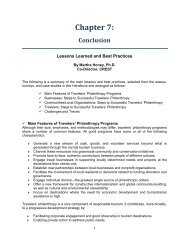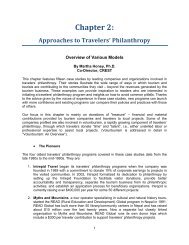Travelers' Philanthropy Handbook - Center for Responsible Travel
Travelers' Philanthropy Handbook - Center for Responsible Travel
Travelers' Philanthropy Handbook - Center for Responsible Travel
You also want an ePaper? Increase the reach of your titles
YUMPU automatically turns print PDFs into web optimized ePapers that Google loves.
• The Recipient Must Take OwnershipDoes this matter in terms of implementation? It matters enormously, because at some pointthe recipient has to take ownership – psychological as well as legal and financial – of theproject. If there is no ownership, if the key stakeholder in fact has minimal stake in theproject’s success, then what happens? When the school runs out of supplies; when the wellsilts up or its pump fails and no spare parts are available; when the drip irrigation pipe needs tobe replaced; when the bridge cracks under the pressure of water surging over it in the nextflood; when the school or clinic runs out of basic supplies, then local people will say, “This isn’tour problem. This is something <strong>for</strong> the donor to come fix. After all, it was their idea from thestart. They defined our needs, not we. They set our priorities, not we. They have the money<strong>for</strong> repair and maintenance, not we. We keep waiting <strong>for</strong> them to come to help, and they fail todo their part.” In the meantime, of course, the donor’s charitable investment is essentiallywasted.• Donations Must Include Funds <strong>for</strong> MaintenanceAnyone who has studied the sorry history of much <strong>for</strong>eign aid, involving transactions between adonor government or intergovernmental agency and a recipient government, must acknowledgethe recurring problem of insufficient project maintenance. It’s what happens after a project iscompleted and the ribbon-cutting ceremonies are per<strong>for</strong>med that determines the rate of returnon the investment. But all too frequently negotiations between donors and recipients are overthe nature and location of the project, not over maintenance – or rather, not over who has theresponsibility to cover maintenance costs. Because this key issue is glossed over, each sideincorrectly assumes that the other will take care of problems when they arise. The predictableresult of this misunderstanding is lack of maintenance, lack of spare parts, lack of training torepair machinery that fails. This, in turn, means that when a well silts up or a bridge cracks, therate of return on a substantial infrastructural investment falls to zero. An observation thatapplies to aid relationships between large, bureaucratic governmental agencies applies as wellto the small-scale, unofficial, non-bureaucratic examples on which I have focused.So the dilemma I, the well-intentioned tourist, face is whether to make a quick, impulsivedecision to fund a project in which I have some emotional investment, though with some vagueawareness that it’s not going to be “owned” by the people <strong>for</strong> whose benefit it is intended andconsequently is unlikely to be sustained over time. There is no ready way out of this dilemma.What this discussion indicates is that any negotiations over an aid project – large and small,involving governments or private individuals – should address the critical issue of who funds andadministers project maintenance. If this issue cannot be resolved to mutual satisfaction at earlystages of negotiations, then there is a good case <strong>for</strong> abandoning the project.• Reducing the Risks of FailureLet me conclude with some reflections on what should be done. I’ve focused on the ways inwhich a tourist’s good intentions can lead to negative results. From this a reader mightconclude that tourist philanthropy is a losing proposition and should be abandoned. But that isnot my conclusion. Good intentions, while insufficient <strong>for</strong> ethical action, remain essential188















